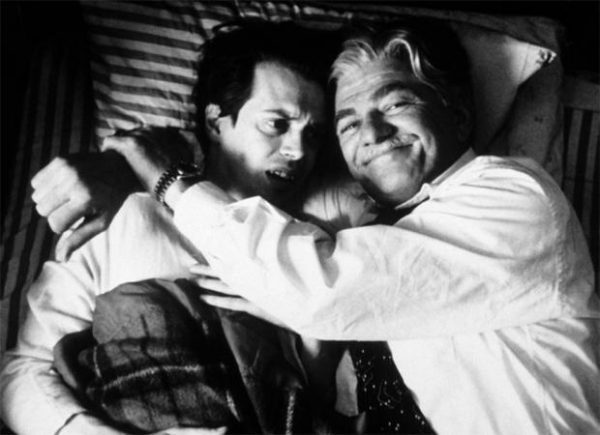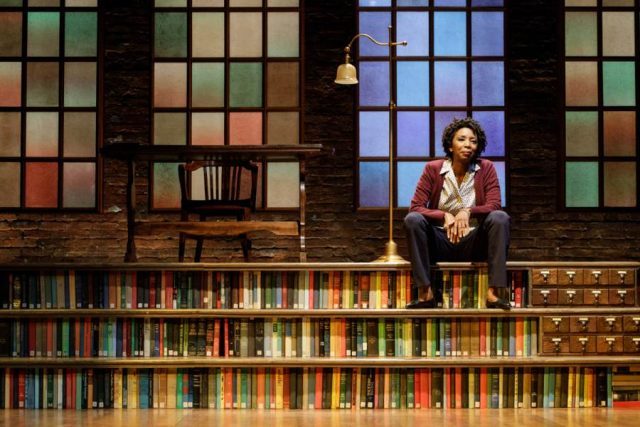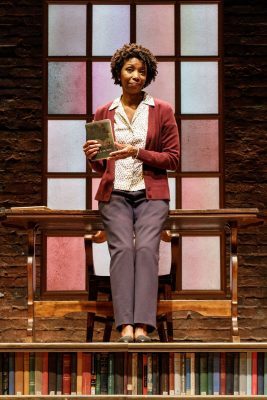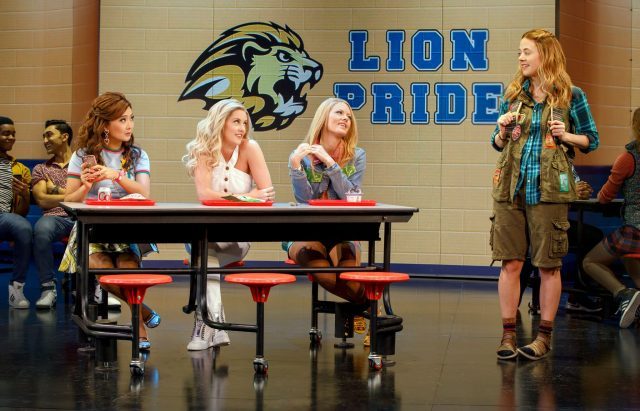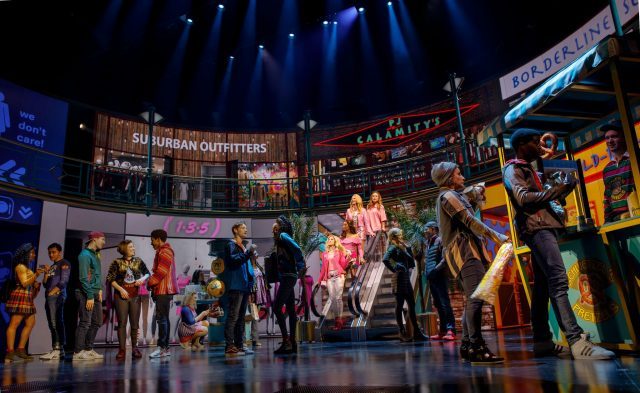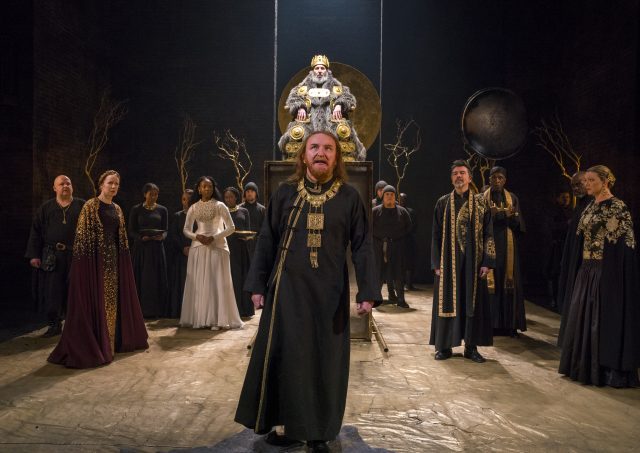
Kent (Antony Byrne) is at the ready as Lear (Sir Antony Sher) enters in Royal Shakespeare production at BAM (photo by Richard Termine)
Brooklyn Academy of Music
BAM Harvey Theater
651 Fulton St.
April 7-29, $35-$125, 7:30 (plus weekend matinees)
718-636-4100
www.bam.org
Sir Antony Sher bids adieu to Shakespeare in a dark version of the already dark King Lear, continuing at BAM’s Harvey Theater through April 27. The Royal Shakespeare Company production takes place in a dank, dreary, dismal world reminiscent of Akira Kurosawa’s The Lower Depths, where poverty and disillusionment reign. As the audience enters the theater, robed and hooded figures slowly walk onstage from the wings and sit on a vinyl tarp covering the ground, which is strewn with black gravel, while hellish mist floats in. After several minutes, they leave and a door in the back wall opens; Lear, wearing an enormous, brutal, bearlike fur coat, makes his entrance, sitting on his throne atop a large box with transparent sides. The members of the court are all dressed in black, some with gold adornments, except for one woman, who we soon learn is Cordelia (Mimi Ndiweni). Prepared to divide his kingdom into thirds, Lear listens as first Goneril (Nia Gwynne), who is married to the Duke of Albany (Clarence Smith), then Regan (Kelly Williams), wed to the Duke of Cornwall (James Clyde), profess their undying love for their father, and each is rewarded with their share of the kingdom. But when Cordelia, the youngest daughter, tells Lear she loves him as a child should love a parent, refusing to damn him with faint praise, he disinherits her. Lear’s trusted friend and adviser, the Earl of Kent (Antony Byrne), questions the king’s decision, so he is exiled. Afterward, another of Lear’s advisers, the Earl of Gloucester (David Troughton), is tricked by his illegitimate son, Edmund (Paapa Essiedu), into believing that his older son, Edgar (Oliver Johnstone), has plotted against him, leading Edgar to run away and disguise himself as Poor Tom, a crazy wanderer. Things don’t go well from there for anyone in the play, which was inspired by Raphael Holinshed’s Chronicles of England, Scotland, and Ireland and Sir Philip Sidney’s Countess of Pembroke’s Arcadia.
The Brooklyn Academy of Music has been presenting Lear for more than 150 years, with a wide range of actors portraying the king, from Ernesto Rossi and Edwin Booth to Frank Langella and Sir Derek Jacobi. “It’s all Ian McKellen’s fault,” Sher writes at the beginning of his latest book, Year of the King: The Lear Diaries; McKellen played Lear at BAM in 2007. Directed by RSC artistic director Gregory Doran, Sher’s longtime partner, this Lear is more subtle than most, if that word can be used at all to describe the Bard’s monumental tragedy. The sixty-eight-year-old Sher plays Lear as a sad, gentle, at times spoiled child who is already in decline before completely unraveling. With great understatement he towers over everyone in the storm scene, high atop the box, video of a rushing waterfall raging behind him, but he has already lost it all. Byrne is a fine, forceful Kent, boasting a shaved head with a warriorlike tattoo; he’s determined to bring the king back to reality, but he knows it’s too late. Troughton is magnificent as Gloucester, a pathetic figure on his way to certain doom, his hair so disheveled you want to go onstage and hug him (and comb his dreary locks). Johnstone’s Edgar is heartbreaking as well, a kind of sprite who has been beaten down by a cruel world he can’t understand. And Graham Turner is a memorable Fool, a tall, strong clown whose mind and body break down over time.
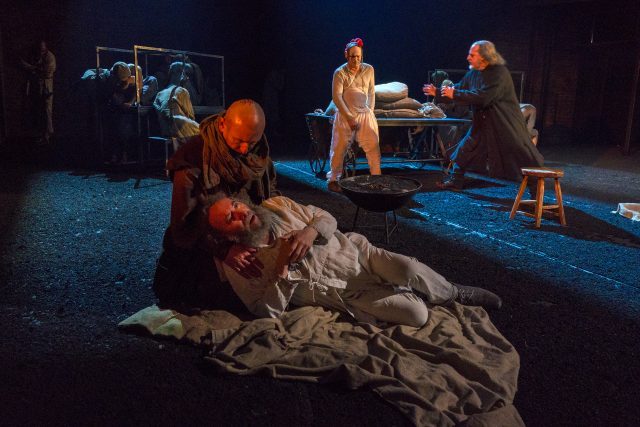
Kent (Antony Byrne) attends to a failing Lear (Sir Antony Sher) as the Fool (Graham Turner) looks on (photo by Richard Termine)
Niki Turner’s set is mostly spare, with various objects, from small trees to chairs and tables to large circles on poles representing the sun and the moon, carried by the cast. The large box is a curious addition that might not completely work — perhaps it’s a metaphor for peering inside the minds of the characters, particularly Lear’s, or else is a sign of being trapped — but it is eerily effective in the blinding scene, blood spurting and splashing onto the transparent sides. Doran focuses on the act of seeing throughout the play, giving prominence to lines about sight and eyes. “What, art mad? A man may see how this world goes with no eyes,” Lear tells Gloucester. “’Tis the times’ plague, when madmen lead the blind,” the Fool says to the old man (Edward James Walters). Tim Mitchell’s lighting, Jonathan Ruddick’s sound design, and Ilona Sekacz’s music, performed by musicians on balconies on the right and left of the stage, combine for a threatening atmosphere; the goings-on grow so somber that a surprising amount of the audience did not return after intermission for the second act, although I’d like to think that was more because those patrons were not prepared for nearly three and a half hours of gloom and doom. But this is Lear, after all, in this case featuring one of the world’s greatest Shakespearean actors taking his final Bard bow. It might be more of a whisper than a scream, but it is majestic and monumental nonetheless.
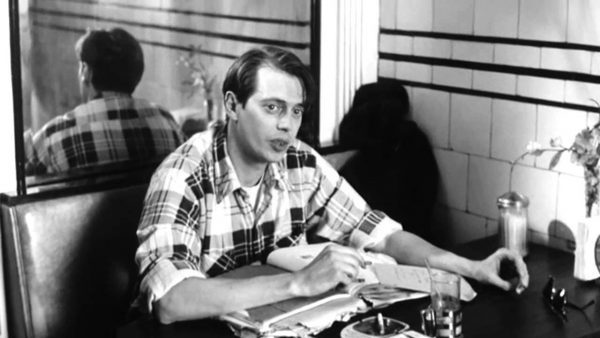
 The 2018 Tribeca Film Festival might be hosting gala anniversary screenings of Scarface and Schindler’s List at the Beacon with impressive rosters of superstar guests and high price tags, but the one to see is Alexandre Rockwell’s 1992 black-and-white indie cult classic, In the Soup, which is being shown April 24 at the SVA Theater. The twenty-fifth anniversary screening is a case of life imitating art (imitating life): The black comedy is about the fabulously named Adolpho Rollo (Steve Buscemi), a ne’er-do-well New Yorker living in a run-down apartment building, working on his master opus, a five-hundred-page screenplay called Unconditional Surrender that he believes will change the face of cinema itself. A familiar New York story? Perhaps, but the film was largely unfamiliar to almost everyone but the most dedicated enthusiasts, since it has been out of circulation for most of its existence. A few years ago, In the Soup was down to one last, damaged archival print, but distribution company Factory 25 began a
The 2018 Tribeca Film Festival might be hosting gala anniversary screenings of Scarface and Schindler’s List at the Beacon with impressive rosters of superstar guests and high price tags, but the one to see is Alexandre Rockwell’s 1992 black-and-white indie cult classic, In the Soup, which is being shown April 24 at the SVA Theater. The twenty-fifth anniversary screening is a case of life imitating art (imitating life): The black comedy is about the fabulously named Adolpho Rollo (Steve Buscemi), a ne’er-do-well New Yorker living in a run-down apartment building, working on his master opus, a five-hundred-page screenplay called Unconditional Surrender that he believes will change the face of cinema itself. A familiar New York story? Perhaps, but the film was largely unfamiliar to almost everyone but the most dedicated enthusiasts, since it has been out of circulation for most of its existence. A few years ago, In the Soup was down to one last, damaged archival print, but distribution company Factory 25 began a 